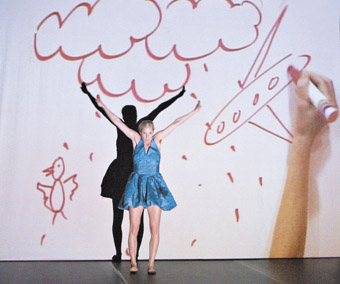 |
Kristy Ayre, Lifesize photo Belinda: artsphotography.net.au |
Conceived by Luke George, Lifesize is a dizzying example of form as content. Taking on the vapid, electronic immediacy of popular culture, George and his collaborators have set themselves the outrageously far-reaching task of distilling more or less the entire postmodern lexicon. Naturally, the result is a multivalent pastiche of art forms, references, digressions and parodies. What remains relatively simple is the overarching narrative, an old-fashioned love story in the guise of a modern one. A man, Luke George, and a woman, Kristy Ayre, exist as individuals: they imagine themselves in a certain way; they imagine a potential lover in a certain way. These acts of imagination allow them to meet each other and to find themselves occupying a new imaginative realm transcending anything they could have imagined in isolation. It sounds complicated but this trajectory is nothing new; imagination has existed far longer than YouTube. What has changed is the degree of commodification.
Imagination is now more purchasable and externalised than ever. Imagined worlds and personas can be published and shared with no delay in gratification. In turn, this all feeds and is itself nourished by what is inadequately referred to as ‘celebrity culture’—it is, quite often, notoriety culture. The result is disposability, millisecond relevance and instantaneous feedback. So, the challenge for Lifesize is to be able to cannibalise this undeniably fascinating vein of material without itself being devoured in the process.
Lifesize begins very simply. Ayre is clad in a turquoise dress that, from a distance at least, looks like a taffeta high school dance affair. She stands demurely, facing slightly away from us; three standing lamps positioned to her side cast her in an unbalanced light. Her face is obscured, her shape seen in dramatic chiaroscuro. She begins to move a little more violently than the dress suggests is appropriate and when her face does appear her eyes are distant and disengaged. She turns on a video camera and steps in front of it. Positioned on the floor, the camera picks up her feet and legs. This live image is fed to a digital projector and shone on the full aspect of the rear wall.
The use of live cameras in performance always puts the audience in the dilemma of which to watch. In Lifesize, this dilemma forms part of the piece’s investigation of simulacra. Ayre is a perfectly watchable performer at any time, so why does the audience’s attention switch so readily to the screen? What the camera offers is, first and foremost, the opportunity to see what Ayre’s character wants us to see. Also, in a live performance, we as an audience are conscious of our physical presence and the barrier to invisible voyeurism that this puts up. When a camera is used as it is in Lifesize, our sense of seeing through the character’s eye serves to eliminate this corporeal barrier. We are removed from our chairs and placed inside the head of the character—the realm of psychology that is so important to filmmaking.
The sideways slant of the light still serves to obscure elements of Ayre’s body but in the camera’s gaze it is clear that this is part of her conceit, part of the image she is trying to manufacture, rather than any demureness. In a subsequent sequence, this coy bit of foreplay is exploded into an astonishing moment of faux amateur porn. As Barry White, slowed to a drawl, plays in the background, Ayre and George video grotesque close-ups of themselves creating lurid scenes with innocuous body parts—an elbow joint becomes a crotch with a moustachioed man eagerly licking, a hairy belly button becomes an improbably sexualised orifice that sings. To make fun of porn is nothing new, but to make porn truly funny is a very enjoyable achievement.
Lifesize gallops apace through references to dating services, Bindi Irwin, scrapbooks and tabloid magazines. At times, it skirts a fine line between professional exploration of subject matter and amateur infatuation, but this is part of the fun. To make something about pop culture, you have to know pop culture. And to know something you aspire to, as well as wish to explore, you have to like it. Luke George likes pop culture.
Lifesize, choreography Luke George, performers Luke George, Kristy Ayre, sound Luke Smiles, video Martyn Coutts, lighting Benjamin Cisterne, Dancehouse, March 12-13; Dance Massive, Melbourne, March 3-15
RealTime issue #90 April-May 2009 pg. web
© Carl Nilsson-Polias; for permission to reproduce apply to [email protected]








 back
back